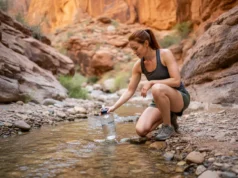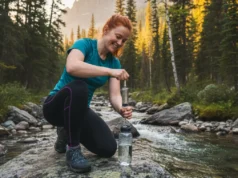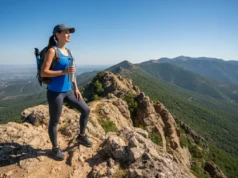In this article
The wrong water bottle is more than an inconvenience; it’s a dead weight in your pack, lukewarm water when you’re parched, or even a critical safety failure in the backcountry. Choosing the right travel water bottle isn’t about finding a single “best overall” bottle—it’s about understanding the mission-critical trade-offs between weight, durability, insulation, and function, and matching the perfect tool to your specific hiking style. This isn’t just another list of products. This is a guide to thinking like a gear pro, so you can find a good travel water bottle that is truly trail-ready for any activity, from a day at the gym to multi-day treks.
We’re here to cut through the noise. Forget the hype and the endless “top 10” lists that treat a simple plastic bottle the same as a high-tech filter & purifier. We’ll give you the expert’s framework to evaluate any bottle on your own terms. First, you will learn the six key criteria—from durability to backcountry water filtration compatibility—that define a bottle’s true worth on the trail. Then, you’ll discover your hiker persona, whether you’re a casual Day Hiker, a relentless Thru-Trekker focused on ultralight backpacking, or a safety-obsessed Backcountry Purist. Finally, you’ll see our field-tested recommendations, curated and scored for a Trail Readiness Rating, so you can understand exactly why an ultralight thru-hiker’s favorite $2 bottle is just as “good” as a day-hiker’s premium $50 insulated flask.
How to Choose the Right Travel Water Bottle: An Expert’s Framework
To make a smart, confident choice, you need to think like a gear analyst. This means moving beyond brand reputation and color options to the core principles that dictate performance. We’ll arm you with the objective knowledge to see a water bottle not as an accessory, but as a critical piece of your hiking system for active travel.
Why Does Material Dictate Durability and Safety?
The material of your water bottle is its DNA, defining its strength, weight, taste neutrality, and even its performance across seasons. The most common choice for insulated bottles is 18/8 pro-grade Stainless Steel. It’s incredibly tough, offers excellent odor resistance, and won’t shatter, but a hard drop can cause dent resistance issues and compromise the double-walled vacuum seal, ruining its insulating properties forever. For clear, non-insulated bottles, BPA-free Tritan Copolyester is the star. It’s strong and doesn’t hold onto flavors, but it has an Achilles’ heel: in deep-freezing temperatures, it can become brittle and shatter if dropped.
This is where High-Density Polyethylene, or HDPE, comes in. Found in those classic, opaque Nalgene bottles, HDPE is more pliable and forgiving in the cold, making it a superior and more reliable four-season choice for non-insulated needs. Finally, for a collapsible bottle, Thermoplastic Polyurethane (TPU) or food-grade silicone is the standard. Its durability isn’t about impact resistance, but about its ability to withstand punctures and the long-term integrity of its welded seams.
But durability often comes with a penalty that long-distance hikers can’t afford: weight.
Water Bottle Material Comparison
A guide to choosing the right material for your hydration needs, from daily use to extreme adventures.
Key Pros & Cons
Pros: Incredibly tough, excellent odor resistance, won’t shatter, great insulation.
Cons: Heavy, hard drop can ruin vacuum seal, dent resistance issues.
Best For & Examples
Use Cases: Insulated all-season use, car camping.
Examples: Hydro Flask, YETI, Klean Kanteen.
Key Pros & Cons
Pros: Lightweight, clear, taste-neutral, durable, BPA-free.
Cons: Can become brittle and shatter in freezing temperatures.
Best For & Examples
Use Cases: General hiking, everyday use in mild climates.
Examples: Nalgene (clear bottles), CamelBak Eddy+.
Key Pros & Cons
Pros: More pliable, forgiving in the cold, durable, affordable.
Cons: Opaque, can retain flavors/odors over time.
Best For & Examples
Use Cases: Four-season use, backpacking, budget-conscious.
Examples: Nalgene (opaque bottles).
Key Pros & Cons
Pros: Collapsible, ultralight, packable, puncture-resistant.
Cons: Lower impact durability than hard bottles, can be hard to clean.
Best For & Examples
Use Cases: Thru-hiking, trail running, backpacking to save space.
Examples: Platypus, HydraPak, Katadyn BeFree Flask.
How Do Weight and Packability Impact Your Hike?
For anyone who has hiked more than a few miles, the concept of “base weight”—the weight of your pack before adding food and water—is a constant obsession. For long-distance hikers and those committed to minimalist travel, every single ounce matters. This is where the trade-offs become brutally clear. A disposable Smartwater bottle, the unofficial mascot of the ultralight community, weighs a mere 1.4 ounces. A premium insulated Hydro Flask, by contrast, weighs in at 12.2 ounces—empty. That’s nearly a pound of dead weight before you’ve even added water. By strategically reducing your pack’s base weight, you increase your efficiency, reduce fatigue, and ultimately enjoy the trail more.
Packability goes beyond the scales; it’s also about volume and shape. The tall, slender profile of that same Smartwater bottle is prized by thru-hikers because it slides perfectly into the side pockets of most backpacks, making it easy to grab without stopping. On the other hand, a bottle with a collapsible design, like the Vapur Eclipse, offers a different advantage. These are ultra-packable and save an immense amount of valuable space inside your pack once they’re empty, a feature that becomes more and more valuable as you consume your supplies on a multi-day trek.
For some, the comfort of a temperature-controlled drink is worth the significant weight penalty.
Is Insulation Worth the Weight?
Let’s be clear: insulation is a luxury feature on the trail, representing a direct trade-off of comfort for weight. The magic happens through double-wall vacuum insulation, a technology found almost exclusively in stainless steel bottles. This construction is remarkably effective, capable of keeping drinks cold for up to 24 hours or hot for 12, greatly enhancing a day hike. On hot trails, pulling an ice-cold bottle from your pack at the summit is a game-changing morale boost. Many of these insulated bottles also feature a durable powder coat finish for better grip.
However, that comfort comes at a weight cost that is simply prohibitive for most multi-day backpackers who are already carrying food, shelter, and clothing for the long haul. Your standard plastic or TPU bottles, while lightweight and functional, offer zero meaningful insulation. Your water will be the temperature of the air around it within an hour or two. The decision to carry an insulated bottle is a personal one, but it’s one that should be made with a full understanding of the weight you’ll be adding to your shoulders.
Beyond temperature, the simple act of drinking from a bottle on the move involves its own critical set of trade-offs.
What Makes a Bottle Easy to Use and Clean?
The central ergonomic debate in the water bottle world comes down to one thing: wide-mouth vs. narrow-mouth. A wide-mouth opening, famously championed by Nalgene, is fantastic for ease of filling from a stream, adding ice or electrolyte drink mixes, and getting a brush inside for a thorough cleaning. Its major downside is that it’s notoriously easy to spill water all over your face and chest while trying to drink and walk at the same time.
A narrow-mouth opening, like that on a Smartwater bottle, is far easier to sip from on the move without making a mess. The trade-off is that it’s much harder to fill from shallow water sources and nearly impossible to clean effectively, though many modern bottles are dishwasher safe. Lid design adds another layer of complexity. Simple screw caps are the most reliable and leak-proof, while chug caps offer a more controlled flow, and a straw lid allows for easy one-handed operation but adds more parts for multi-part cleaning, to lose, or potentially freeze in cold weather.
However, for a serious hiker, no ergonomic feature matters more than how the bottle connects to their water filter.
Why is Filter Compatibility a Non-Negotiable for Backpackers?
A hiking water bottle is not a standalone object; it is part of a larger system for hydration and water treatment in the backcountry. The most popular ultralight system on trails today involves pairing a squeeze bottle filter, like the ubiquitous Sawyer Squeeze, directly with a compatible bottle. This is where thread size becomes critically important. The Smartwater bottle’s standard 28mm thread size makes it the undisputed gold standard for direct compatibility with Sawyer filters, allowing hikers to filter water from one bottle to another, or drink directly from the filter itself. Knowing the difference between a water filter and a purifier is the first step in building a safe system for potable water.
Pro-Tip: Always test-fit your filter and bottles at home before a trip. Threading standards can have minor variations between brands and even production runs. A “compatible” thread that leaks under pressure is useless in the field.
Other systems use different standards. Brands like HydraPak and Katadyn often use a wider 42mm thread on their soft flasks. Wide-mouth bottles like a Nalgene are not directly compatible with any screw-on filters and require a separate adapter or a different filtering method entirely. Then there are all-in-one solutions like the Grayl GeoPress, which integrate a powerful purifier directly into the bottle. These offer incredible convenience and safety but often preclude the use of flavored drink mixes, which can clog the filter mechanism. Your bottle choice directly impacts your ability to get safe drinking water, a fact certified by health organizations like NSF International.
Now that you’re armed with the expert’s framework, let’s show you exactly how we applied it to find the best bottles on the market.
Our Selection Process: How We Built This Guide
We are committed to objectivity. We don’t believe in a single “best water bottle,” because the “best” for a thru-hiker is often the worst for a day-tripper. Our mission is to match the right bottle to the right hiker. This guide is built on a foundation of data-driven analysis, expert evaluation, and real-world feedback from the hiking community.
Every product recommended in this guide was rigorously judged against the six critical performance criteria we established above: Durability & Trail-Worthiness, Weight & Packability, Insulation Performance, Hydration Ergonomics, Filter & System Compatibility, and Overall Value. We scored each bottle against these metrics to give you a clear, at-a-glance understanding of its specific strengths and weaknesses.
Our selection process involved two distinct phases. First, we conducted an exhaustive market analysis, synthesizing performance data, specifications, and long-term test results from dozens of independent reviews from trusted sources like OutdoorGearLab, CleverHiker, and Backpacking Light. Second, we took that mountain of data and curated the absolute top-performers for each of our core Hiker Personas, ensuring that every single recommendation is a purposeful fit for a specific need and a specific trail.
A final note on transparency: If you choose to purchase a product through our links, we may earn a small commission at no extra cost to you. This helps support our independent research and allows us to keep creating in-depth guides like this one. Our recommendations are, and always will be, driven by our commitment to you, the reader.
The Best Hiking Water Bottles of 2025: Our Top Recommendations for Every Need
Our Top Picks for The All-Weather Day Hiker
This hiker values comfort and performance for single-day adventures. Weight is a consideration, but not the primary one. They want a reusable water bottle that enhances their drinking experience, whether that means an ice-cold drink at a sweltering summit or a steaming hot beverage on a frosty morning. A leak-proof lid, a sturdy carry handle, durability for everyday use, and great ergonomics are key.
Our Top Picks for The Ultralight Thru-Trekker
For this hiker, every single gram matters. They are embarking on multi-day or multi-month journeys where efficiency and minimalism are paramount. Their gear choices are dictated by a ruthless calculus of weight, packability, and multi-functionality. A water bottle is not a luxury; it is a core component of their life-support system and backcountry water safety plan.
Our Top Picks for The Backcountry Purist / International Adventurer
This user’s primary concern is absolute, unquestionable water safety. They are hiking in remote backcountry where Giardia is a real threat, or traveling in developing countries where waterborne viruses are a significant risk. For them, a water bottle is a piece of survival equipment. Weight, price range, and even taste are secondary to the guarantee of safe drinking water.
Pro-Tip: Any hollow-fiber filter (like Sawyer, Katadyn, or LifeStraw) can be permanently damaged if it freezes after being used. In winter conditions, keep your filter in a pocket close to your body during the day and in your sleeping bag at night. A purifier like the Grayl or chemical treatments are often safer bets for deep-freeze adventures.
Conclusion
The search for the “best” water bottle is a myth. The journey to finding the right water bottle, however, is a matter of matching your gear to your mission. For Thru-Trekkers, where every gram is counted over thousands of miles, the ultralight weight and perfect filter compatibility of a simple Smartwater bottle make it an unparalleled tool that trumps every other feature. For Day Hikers, the calculus is different; features that enhance comfort and user experience, like the premium insulation of a Hydro Flask or the clever ergonomics of a YETI or Owala, provide the most value. And for the Backcountry Purist and International Adventurer, absolute water safety through purification, delivered by a bombproof system like the Grayl GeoPress, is the only metric that truly matters, justifying any penalty in weight or cost.
You’ve seen our analysis and top picks—now we want to hear from you. What’s your go-to hiking water bottle and why? Share your trail-tested favorite in the comments below!
Frequently Asked Questions about Hiking Water Bottles
What’s the difference between a water filter and a purifier?
This is a critical distinction for backcountry safety. A water filter uses a physical barrier to remove larger pathogens like bacteria (e.g., E. coli, Salmonella) and protozoa (e.g., Giardia, Cryptosporidium). A water purifier does all of that plus it eliminates or deactivates tiny viruses (e.g., Hepatitis A, Norovirus). For hiking in North America and Europe, a filter is generally sufficient. For international travel to developing nations or in areas with high human/agricultural impact, a purifier is essential for complete protection. For that level of safety, we recommend a purifier like the Grayl GeoPress.
Are insulated water bottles worth it for hiking?
It depends entirely on your hiking style. For day hikes, especially in very hot or cold weather, an insulated bottle can be a fantastic luxury that dramatically improves your comfort on the trail. For multi-day backpacking or thru-hiking, the significant weight penalty is usually not worth it, as minimizing base weight is the top priority. If you’re a day-hiker who wants the best of both worlds, the Hydro Flask Trail Series offers excellent insulation in a package that’s 25% lighter than standard models, striking a great balance.
What is the most durable water bottle material?
Durability depends on the type of stress. Stainless steel is highly resistant to shattering and is great for all-around abuse, but a sharp impact can dent it and ruin the vacuum insulation. Standard Tritan plastic is very tough but can become brittle and crack if dropped in deep-freezing temperatures. For all-season durability in a non-insulated bottle, HDPE plastic is superior as it remains more pliable in the cold, making the Nalgene Ultralite a very reliable choice. For legendary, everyday toughness backed by a lifetime warranty, the classic Nalgene Sustain is hard to beat.
Why are Smartwater bottles so popular with thru-hikers?
Their popularity comes from a perfect storm of three key features that are optimized for long-distance hiking. First, they are incredibly lightweight, weighing just over an ounce. Second, their tall, slender shape fits perfectly into the side pockets of most backpacks, making them easy to access. Most importantly, their 28mm neck threads are perfectly compatible with the Sawyer Squeeze, which is the most popular water filter among thru-hikers. This combination makes the Smartwater Bottle the central, most efficient component of the ultralight hydration and filtration system used on nearly every long-distance trail.
Risk Disclaimer: Hiking, trekking, backpacking, and all related outdoor activities involve inherent risks which may result in serious injury, illness, or death. The information provided on The Hiking Tribe is for educational and informational purposes only. While we strive for accuracy, information on trails, gear, techniques, and safety is not a substitute for your own best judgment and thorough preparation. Trail conditions, weather, and other environmental factors change rapidly and may differ from what is described on this site. Always check with official sources like park services for the most current alerts and conditions. Never undertake a hike beyond your abilities and always be prepared for the unexpected. By using this website, you agree that you are solely responsible for your own safety. Any reliance you place on our content is strictly at your own risk, and you assume all liability for your actions and decisions in the outdoors. The Hiking Tribe and its authors will not be held liable for any injury, damage, or loss sustained in connection with the use of the information herein.
Affiliate Disclosure: We are a participant in the Amazon Services LLC Associates Program, an affiliate advertising program designed to provide a means for us to earn advertising fees by advertising and linking to Amazon.com. As an Amazon Associate, we earn from qualifying purchases. We also participate in other affiliate programs and may receive a commission on products purchased through our links, at no extra cost to you. Additional terms are found in the terms of service.





